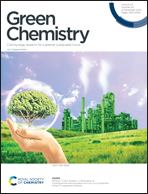Brønsted acid catalysis opens a new route to polythiolesters via the direct condensation of thiolactic acid to thiolactide†
Abstract
Polythiolesters (PTEs) are a rather underinvestigated group of sulfur-containing polymers with high potential as sustainable materials due to their enhanced de-polymerizability under specific conditions compared to polyesters (PEs). Poly(thiolactic acid), the sulfur analog of poly(lactic acid) (PLA), one of the most prominent biobased and biodegradable PEs, was only very recently obtained with relatively high molecular weight by the ring-opening polymerization of thiolactide (TLD). Here, we demonstrate a novel synthesis route to TLD by the direct condensation of thiolactic acid (TLA) with Brønsted acid catalysts in the absence of co-reagents or stoichiometric additives. Homogeneous sulfonic acid catalysts afforded a TLD yield of up to 80% directly from racemic TLA. Heterogenizing the catalytic system is challenging in which sulfonic acid containing ion-exchange resins enabled a maximum yield of 39%, while lower yields were obtained with Brønsted acid beta zeolites (H-BEA, up to 28%). Even though these zeolites are known to be very apt for the synthesis of lactide from lactic acid, there are profound differences due to the presence of sulfur. First, TLA showed a lower tendency toward (poly)condensation than LA, reducing the need for shape-selective catalysis. Second, very strong interactions of TLA, compared to LA, with the zeolite were seen by FT-IR and hypothesized to counteract catalytic activity and induce diffusion limitations or sulfur poisoning. The new methods were assessed according to the principles of green chemistry and compared to the other two existing methods in the literature, showing a significant improvement with regard to sustainability for our Brønsted acid catalyzed direct dehydration of TLA. Finally, the Brønsted acid derived TLD was successfully purified and polymerized into PTEs with molecular weights up to 56.0 kg mol−1, revealing some insights into the TLD ring-opening mechanism.



 Please wait while we load your content...
Please wait while we load your content...